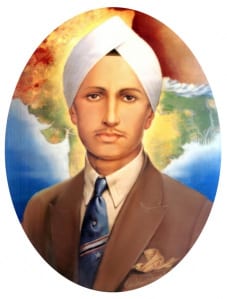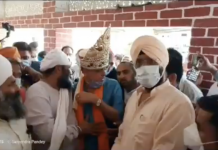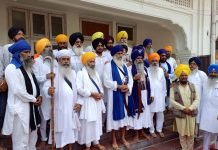“ਸੇਵਾ ਦੇਸ਼ ਦੀ ਜਿੰਦੜੀਅੇ ਬੜੀ ਔਖੀ, ਗੱਲਾਂ ਕਰਨੀਆਂ ਢੇਰ ਸੁਖੱਲੀਆਂ ਨੇ, ਜਿੰਨੇ ਦੇਸ਼ ਦੀ ਸੇਵਾ ਚ ਪੈਰ ਪਾਇਆ, ਓਹਨਾ ਲੱਖ ਮੁਸੀਬਤਾਂ ਝੱਲੀਆਂ ਨੇ.”
Serving ones country is very difficult. It is so easy to talk. Anyone who walked on that path, Must endure millions of calamities
– Shaheed Bhai Kartar Singh Sarabha
Kartar Singh Sarabha, the young Ghadar revolutionary, was born in 1896, in the village of Sarabha, district Ludhiana, Punjab. After receiving his primary education in his own village, Kartar Singh entered the Malwa Khalsa High school at Ludhiana before joining college in Orissa. He had a revolutionary temperament from his early childhood. A study of his life at school shows that he thought very differently from his classmates. He led his class-fellows in sports. He organized school children against the wrongful acts of the teachers.
In 1912, when he was barely 16 years old, he sailed for San Francisco (U.S.A), and joined the University of California at Berkeley, enrolling for a degree in chemistry. To make ends meet, Kartar Singh joined many of his Indian compatriots in taking up work in the countryside of California as a farm laborer.



There he came face to face with the exploitation attitude of American farmers, and the scorn of the average American worker for Indians. He soon realized slavery to be the biggest curse heaved upon a nation. He exchanged views with his countrymen. The scornful attitude of Americans had opened the eyes of Indians, who could no longer tolerate the satirical atmosphere addressed towards them. Kartar Singh came across many other Indians who shared his views. He collected them together, and organized a meeting in which Lala Har Dayal, Pandit Jagat Ram Rihana, Bhai Jawala Singh, and many Indian students, and workers, participated. They deliberated on the causes of the continued enslavement of India. It was felt that a very strong organization was necessary to lead, and carry on, the battle for liberation. This meeting of minds was a prelude to the creation of the organization but it could not carry out any agenda on its own.
During this period, Indian workers in the factories of Oregon, and Washington, states had raised their consciousness to a level where they were able to lay the foundations of an organization. The Ghadar Party was founded in March 1913, in Astoria of Washington state. Kartar Singh was beside himself with joy upon hearing news of the launching of the organization. He joined the party immediately.
The Ghadar newspaper, which made its appearance on the 1st of November, 1913 owed a lot to his efforts. The newspaper was printed on a hand-operated machine, and Kartar Singh not only wrote the Punjabi text, but also operated the machine, and composed patriotic poetry for it. He also went out among the Sikh farmers, and arranged meetings at which he, and other Ghadar leaders, made speeches urging them to united action against British.
As World War I broke out, members of Ghadar party were openly exhorted and returned to India to make an armed revolt against the British. Kartar Singh left the United States on September 15, 1914, nearly a month ahead of the main body of Sikhs, who were to follow. He returned to India via Colombo, resolved to set up in his village a center on the model of Ghadar party’s Yugantar Ashram in San Francisco. When Bhai Parmanand arrived in India in December 1914 to lead the movement, Kartar Singh was charged with spreading the network in the Ludhiana district.
To strengthen the connection, he went to Bengal to secure weapons, and made contacts with revolutionaries such as Visnu Ganesh Pingley, Sachindra Nath Sanyal, and Rash Bihari Bose. Along with Pingley, Kartar Singh visited cantonments at Meerut, Agra, Benaras, Allahabad, Ambala, Lahore ,and Rawalpindi, with a view to incite soldiers to revolt. However just before the planned revolt was to erupt, there was a massive roundup of the Ghadar leaders, following disclosures made by a police informer, who had gained admittance into the party. Kartar Singh was told to leave the country, and escape to Kabul, but his conscience did not allow him to leave the battlefield. He was finally arrested on the 2nd of March, 1915 at Wilsonpur, in Shahpur district, where they had gone to incite the troops of the 22nd Cavalry.
The trial of arrested leaders in the Lahore conspiracy cases of 1915-1916 highlighted the role of Kartar Singh Sarabha in the movement. Kartar Singh, and six of his comrades were hanged until death in Lahore Central Jail on the 16th of November, 1915. Kartar Singh put the noose around his neck himself, and laughed away death, immortalizing himself. In the short span of life he spent on this earth, and despite his youth, and lack of experience, Kartar Singh sacrificed his life in the cause of liberation of humanity at large, and his countrymen in particular.




